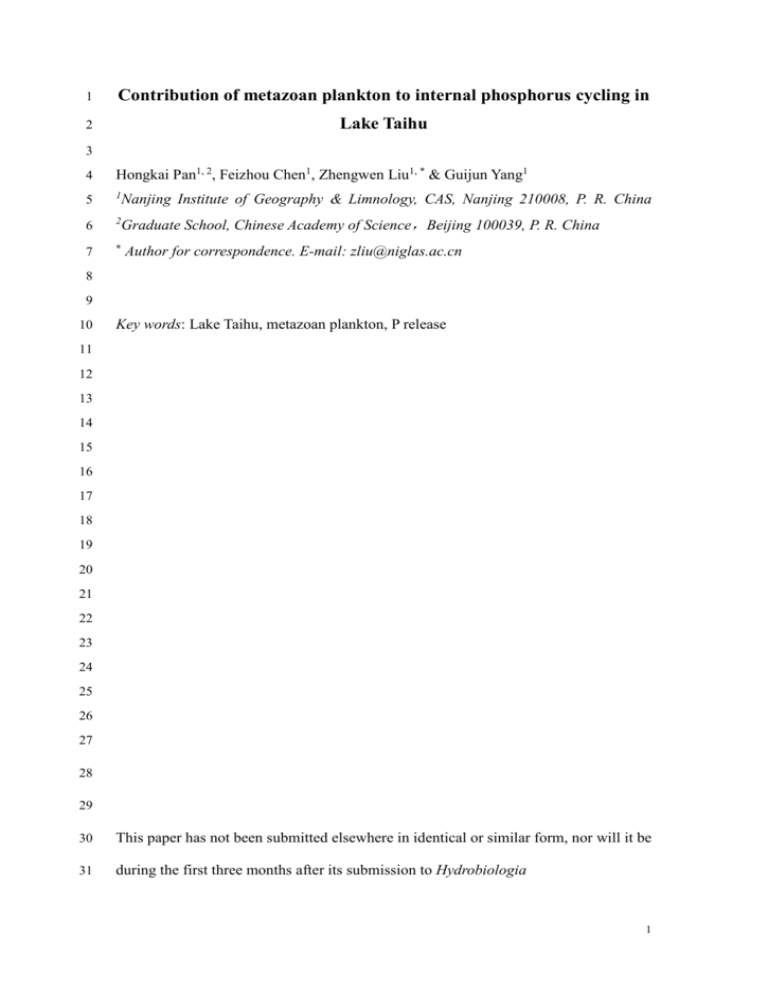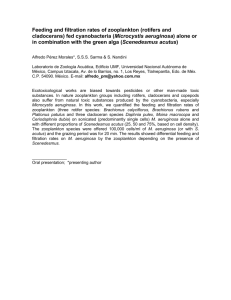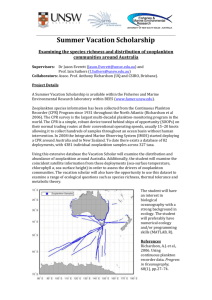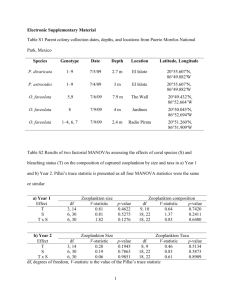P excretion rates of zooplankton in the season
advertisement

1 Contribution of metazoan plankton to internal phosphorus cycling in 2 Lake Taihu 3 4 Hongkai Pan1, 2, Feizhou Chen1, Zhengwen Liu1, * & Guijun Yang1 5 1 Nanjing Institute of Geography & Limnology, CAS, Nanjing 210008, P. R. China 6 2 Graduate School, Chinese Academy of Science,Beijing 100039, P. R. China 7 * Author for correspondence. E-mail: zliu@niglas.ac.cn 8 9 10 Key words: Lake Taihu, metazoan plankton, P release 11 12 13 14 15 16 17 18 19 20 21 22 23 24 25 26 27 28 29 30 This paper has not been submitted elsewhere in identical or similar form, nor will it be 31 during the first three months after its submission to Hydrobiologia 1 1 Abstract 2 The contribution of metazoan plankton to internal phosphorus (P) cycling was 3 investigated in a eutrophic, shallow lake (Lake Taihu, China) in spring 2004 by 4 determining biomass and biomass specific P release rates. Sampling was performed in 5 Meiliang and Wuli Bays. Zooplankton in eutrophic Meiliang Bay was dominated by 6 cladocerans, particularly Daphnia spp. and copepods, while the dominant groups in 7 hypereutrophic Wuli Bay included rotifers, copepods, and cladocerans. Release rates 8 of PO4-P ranged from 0.21 - 0.57 mg P gDW-1 h-1 in Meiliang Bay and from 0.20 - 9 0.76 mg P gDW-1 h-1 in Wuli Bay. In most cases, P release rates were higher in Wuli 10 Bay than Meiliang Bay. Phosphorus flux estimates from zooplankton excretion varied 11 from 3.34 - 48.63 mg P m-2 d-1 in Meiliang Bay and 4.59 - 66.95 mg P m-2 d-1 in Wuli 12 Bay. Since P released by zooplankton in this study was in a form available to 13 phytoplankton, zooplankton may have a large impact on the ecosystem of Lake Taihu. 2 1 Introduction 2 Lake Taihu is a large, shallow, eutrophic lake in eastern China. Although the lake is 3 well mixed and turbid due to sediment resuspension, a clear water phase may be 4 observed in spring and early summer due to low phytoplankton abundance (Liu, 5 unpubl. data). Water transparency decreases later in summer due to Microcystis 6 blooms,while large zooplankton, particularly Daphnia spp., decrease in density. High 7 densities of large zooplankton, particularly cladocerans, are key to regulating 8 phytoplankton biomass and species composition (Carpenter et al., 1987; Reynolds, 9 1994). However, zooplankton also influence phytoplankton via nutrient excretion 10 (Lehman, 1980a; Elser et al., 1988; Sterner & Hessen, 1994). Phosphorus often limits 11 biological production in lakes, and zooplankton excretion is an important P source 12 (Peters & Rigler 1973; Lehman, 1980b; Urabe et al., 1995; Vadstein et al., 1995). 13 This paper evaluates the role of P release by zooplankton to nutrient cycling in 14 Lake Taihu in spring. This was achieved by experimental determination of excretion 15 rates multiplied by zooplankton biomass in the lake. 16 17 Materials and methods 18 Zooplankton was collected with a tube sampler about every two weeks at two stations 19 in Lake Taihu, one in eutrophic Meiliang Bay and another in hypereutrophic Wuli Bay 20 (Fig. 1). Organisms were filtered with a 63-m sieve into plastic vials and preserved 21 with 5% formalin solution. The samples were identified according to Wang (1961), 22 Zhuge (1997), Shen (1979) and Chiang & Du (1979). The animals were counted, and 23 the lengths of 20 - 30 individuals measured using a microscope. Zooplankton biomass 24 (dry weight) was estimated according to length-weight relationships from the 25 literature (Dumont et al., 1975; Huang & Hu, 1986). 26 On each experiment day, zooplankton were collected with horizontal hauls using 27 a 63-m mesh net. Animals were transferred into a 20-l tank containing filtered lake 28 water and transported to the laboratory, where zooplankton were concentrated with a 29 63-m sieve. After rinsing three times with distilled water, animals were transferred 30 into three experimental flasks containing 500 ml filtered (0.45-m) lake water. 31 Temperature was maintained at or near in situ lake temperature. Three reference flasks 32 without animals were run during each experimental series as controls. After 33 incubation (1h), a 200-ml water sample was taken by a pipette with the tip opening 3 1 covered with a fine-mesh net to prevent particle introduction, such as feces. Water 2 samples were analyzed for PO4-P according to Murphy & Riley (1962). 3 At the end of the experiments, animals in each flask were filtered onto GF/C 4 filters and dried at 60C for 24 h. Dry biomass was determined using a microbalance. 5 Phosphorus (PO4-P) release rates were calculated as the difference between 6 experimental and control flasks and expressed per gram dry biomass per hour. 7 Zooplankton community P flux was estimated by multiplying release rates by 8 zooplankton biomass (expressed as gDW m-2) on each day. 9 10 Results 11 Metazoan plankton composition during the study period was similar in the two bays, 12 but there were differences in dominant species. In Meiliang Bay, the dominant species 13 included cladocerans Daphnia hyalina, D. longispina, D. pulex, Moina spp., Bosmina 14 spp. and copepods Sinocalanus dorrii, Cyclops vicinus vicinus, C. strenuous, 15 Thermocyclops taihokuensis. However, in Wuli Bay, the dominant zooplankton 16 species were rotifers Brachionus calyciflorus, B. angularis, Asplanchna priodonta, 17 Keratella tropic, Polyarthra spp., Filinia longiseta, copepods Cyclops vicinus vicinus, 18 Cyclops strenuous, Thermocyclops taihokuensis, Mesocyclops thermocyclopoides and 19 cladocerans Moina spp. 20 Biomass (dry weight) of metazoan plankton in Meiliang Bay was variable (Fig. 21 2). Cladocerans, dominated by Daphnia spp. from March to April and Bosmina spp. 22 and Moina spp. in late May, were the largest component of zooplankton biomass, 23 followed by copepods, while the biomass of rotifers was negligible. 24 In Wuli Bay, however, rotifers contributed a significant portion to zooplankton 25 biomass. Although cladocerans also were an important contributor to zooplankton 26 biomass, the proportion was lower than in Meiliang Bay, and copepod biomass was 27 similar in the two bays. 28 Mean P release rates ranged from 0.21 to 0.57 mg P gDW-1 h-1 in Meiliang Bay 29 and from 0.20 to 0.76 mg P gDW-1 h-1 in Wuli Bay (Fig. 3). In most cases, P release 30 rates were higher in Wuli Bay than in Meiliang Bay. 31 Based on biomass (data from Fig. 2 were converted to gDW m-2) and release 32 rates, zooplankton contribution to internal P cycling was estimated (Fig. 4). 33 Phosphorus flux varied from 3.34 - 48.63 mg P m-2 d-1 in Meiliang Bay and 4.59 - 4 1 66.95 mg P m-2 d-1 in Wuli Bay. Maximal values for P flux occurred at highest 2 zooplankton biomasses. 3 4 Discussion 5 Zooplankton are important in phytoplankton succession during spring and summer via 6 grazing activity (Sommer et al., 1986). However, nutrient regeneration by 7 zooplankton also is an important factor. Earlier studies revealed that most soluble P 8 released by zooplankton is in the form of PO4-P and, therefore, is available to 9 phytoplankton (Lehman, 1980a). During the study period, large zooplankton were 10 abundant in Lake Taihu. The highest biomass of Daphnia spp. was more than 2.0 11 mgDW l-1. Zooplankton P release rates were variable but fall within ranges reported in 12 other studies. In an experimental study, Lehman (1980b) reported a range of 0.58 - 13 0.83 mg P gDW-1 h-1 for zooplankton P release rates. Urabe et al. (1995) showed that 14 zooplankton P release rates in Lake Biwa ranged from 0.01 - 0.11 mg P gDW-1 h-1. In 15 a tropical reservoir, Pinto-Coelho & Greco (1999) reported zooplankton P excretion 16 rates from 0.49 - 1.05 mg P gDW-1 h-1. 17 Our results showed differences in P release rates between the two bays. In most 18 cases, P release rates were higher in Wuli than Meiliang Bay, which may be attributed 19 to differences in zooplankton community structure. Wuli Bay is close to the urban 20 area of Wuxi (population > 100 million) and receives (treated and untreated) sewage. 21 There were more rotifers in Wuli than Meiliang Bay, while large zooplankters, mainly 22 Daphnia spp., were more numerous in Meiliang Bay. Nutrient release rates are related 23 inversely to zooplankton size (Pérz-Martínez & Gulati, 1999; Ruan, 1999). Given 24 equal biomass, small zooplankters, such as rotifers, should play a more important role 25 in P cycling than large-sized zooplankton, such as daphnids (Ejsmont-Karabin, 1983; 26 Ejsmont-Karabin et al., 2004). Difference in zooplankton composition likely is a main 27 factor explaining differences in P release rates between Meiliang and Wuli Bay. 28 Contribution of zooplankton to internal P cycling was estimated by multiplying 29 biomass specific excretion rates by integrated biomass on each sampling date. The 30 lowest estimate was 3.34 mg P m-2 d-1 in Meiliang Bay when zooplankton biomass 31 was lowest, while the highest value of 66.95 mg P m-2 d-1 was observed when biomass 32 was highest in Wuli Bay. A recent study showed that mean PO4-P release from 33 Meiliang Bay sediments was below 3.0 mg P m-2 d-1 (Fan, unpub. data). In 1998, the 5 1 external load of total P to Lake Taihu was ~10.0 mg P m-2 d-1 (Qin et al., in press), 2 which is the same order of magnitude as PO4-P flux from zooplankton excretion. 3 Considering that P released by zooplankton in this study was in a form available to 4 phytoplankton, zooplankton may have a large impact on the Lake Taihu ecosystem. 5 6 Acknowledgements 7 Funds for this study were provided by NSFC (No: 40371103), NIGLAS (No: 8 CXNIGLAS-402-03) and CAS (No: KZCX1-SW-12). The authors are grateful to 9 Peisheng Huang, Xiaolan Song and Shouxuan Wu for their assistance in sampling and 10 chemical analyses, and Mark McCarthy for English correction and valuable 11 suggestions. 12 13 References 14 Carpenter, R., J. F. Kitchell, J. R. Hodgson, P. A. Cochran, J. J. Elser, M. M. Elser, D. 15 M. Lodge, D. Kretchmer, X. He & C. N. von Ende, 1987. Regulation of lake 16 primary productivity by food web structure. Ecology 68: 1863-1876. 17 18 Chiang, S. C. & N. S. Du, 1979. Fauna Sinica, Crustacea, Freshwater Cladocera. Science Press, Academia Sinica, Beijing. 19 Dumont, H. J., I. Van de Velde & S. Dumont, 1975. The dry weight estimate of 20 biomass in a selection of Cladocera, Copepoda and Rotifer from the plankton, 21 periphyton and benthos of continental waters. Oecologia 19: 75-97. 22 23 Ejsmont-Karabin, J., 1983. Ammonia nitrogen and inorganic phosphorus excretion by the planktonic rotifers. Hydrobiologia 104: 231-236. 24 Ejsmont-Karabin, J., Z. Gorelysheva, K. Kalinowska & T. Weglenska, 2004. Role of 25 Zooplankton (Ciliata, Rotifera and Crustacea) in phosphorus removal from 26 cycling: lakes of the river Jorka watershed (Masuria Lakeland, Poland). Polish 27 Journal of Ecology 52: 275-284. 28 Elser, J. J., M. M. Elser, N. A. MacKay & S. R. Carpenter, 1988. Zooplankton 29 mediated transitions between N- and P-limited algal growth. Limnology and 30 Oceanography 36: 64-90. 31 Huang, X. F. & C. Y. Hu, 1986. Regression equations of the body weight to body 32 length for common freshwater species of cladoceran. In Transactions of the 33 Chinese Crustacean Society, No. I, Science Press. 6 1 Lehman, J. T., 1980a. Nutrient recycling as an interface between algae and grazers in 2 freshwater communities. In Kerfoot, W. C. (ed.), Evolution and Ecology of 3 Zooplankton Communities. The University Press of New England, Dartmouth. 4 pp. 251–263. 5 6 7 8 9 10 Lehman, J. T., 1980b. Release and cycling of nutrients between planktonic algae and herbivores. Limnology and Oceanography 25:620-632. Pérz-Martínez, C. & R. D. Gulati, 1999. Species-specific N and P release rates in Daphnia. Hydrobiologia 391: 147-155 Peters, R. H. & D. Lean, 1973. The characterization of soluble phosphorus released by limnetic zooplankton. Limnology and Oceanography 18:270-279. 11 Pinto-Coelho, R. M. & M. K. B. Greco, 1999. The contribution of water hyacinth and 12 zooplankton to the internal cycling of phosphorus in the eutrophic Pampulha 13 Reservoir, Brazil. Hydrobiologia 411: 115 - 127. 14 15 Qin, B., P. Xu, Q. Wu & C. Luo, in press. Eco-environmental issues of Lake Taihu, China. Hydrobiologia 16 Ruan, J. R., 1999. Estimation of orthophosphate release rate of zooplankton in 17 freshwater microcosms. Acta Hydrobiologica Sinica 23: 204-209 (in Chinese 18 with an English abstract). 19 20 21 22 Reynolds, C. S., 1994. The ecological basis for the successful biomanipulation of aquatic communities. Archiv für Hydrobiologie 130: 1-33. Shen, J. R., 1979. Fauna Sinica, Crustacea, Freshwater Copepoda. Science Press, Academia Sinica, Beijing (in Chinese). 23 Sommer, U., Z. M. Gliwicz, W. Lampert & A. Duncan, 1986. The PEG-model of 24 seasonal succession of planktonic events in fresh waters. Archiv für 25 Hydrobiologie 106:433-471. 26 27 Sterner, R. W. & D. O. Hessen., 1994. Algal nutrient limitation and the nutrition of aquatic herbivores. Annual Review of Ecology and Systematic 25:1-29. 28 Urabe, J., M. Nakanishi & K. Kawabata, 1995. Contribution of metazoan plankton to 29 the cycling of nitrogen and phosphorus in Lake Biwa. Limnology and 30 Oceanography 40: 232-241. 31 Vadstein, O., O. Brekke, T. Andersen & Y. Olsen, 1995. Estimation of phosphorus 32 release rates from natural zooplankton community feeding on planktonic algae 33 and bacteria. Limnology and Oceanography 40: 250-262. 34 Wang, J. J., 1961. Fauna Sinica, Rotifera, Science Press, Academia Sinica, Beijing (in 7 1 Chinese). 2 Zhuge, Y., 1997. Studies on taxonomy and distribution of Rotifera in typical zones of 3 China. Doctoral dissertation, Institute of Hydrobiology, Chinese Academy of 4 Sciences (in Chinese with an English abstract). 5 8 1 Figure captions: 2 Figure 1. Sampling stations in Meiliang Bay and Wuli Bay, Lake Taihu. 3 Figure 2. Biomass (dry weight) composition of metazoan plankton of Meiliang Bay 4 5 6 7 8 and Wuli Bay, Lake Taihu during the study period. Figure 3. Phosphorous release rates of zooplankton in Meiliang Bay and Wuli Bay, Lake Taihu during the study period. Vertical bar shows standard deviation. Figure 4. Phosphorus flux by metazoan plankton in Meiliang Bay and Wuli Bay, Lake Taihu during the study period. 9 1 Figure 1 2 3 4 5 6 Lake Taihu Wuli Bay N 7 8 9 Meiliang Bay 10 11 12 13 14 15 10 km Sampling Station 16 17 10 1 2 Figure 2 3.0 2.5 Wuli Bay 2.0 1.5 -1 Biomass (mg DW l ) 1.0 0.5 Rotifers Copepods Moina Bosmina Daphnia 0 3.0 2.5 Meiliang Bay 2.0 1.5 1.0 0.5 0 3 March April May 11 1 2 Figure 3 P release rate (mg gDW -1 l -1 ) 1.2 Meiliang Bay 1.0 Wuli Bay 0.8 * 0.6 * * * 0.4 0.2 0.0 3.9 3 3.18 3.26 4.6 4.15 4.22 5.16 5.25 Date 12 1 Figure 4 -2 -1 P flux (mg m d ) 80 70 Meiliang Bay 60 Wuli Bay 50 40 30 20 10 0 3.9 2 3 4 3.18 3.26 4.6 4.15 4.22 5.16 5.25 Date 13







